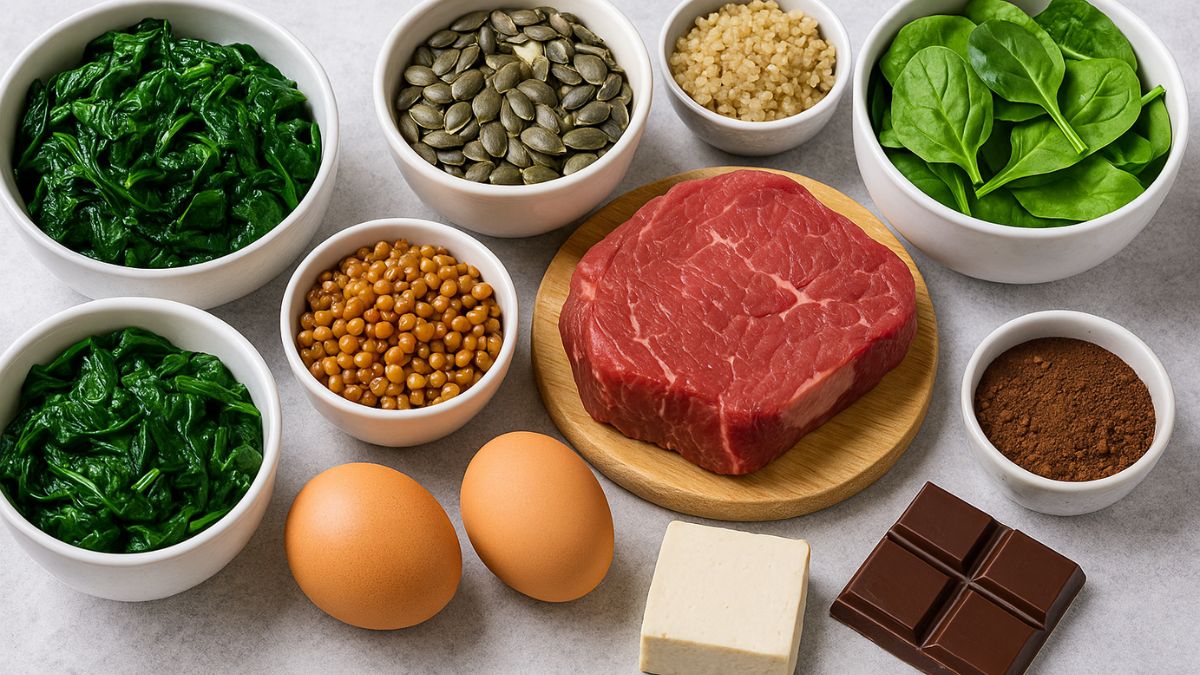New York: If you’ve been feeling unusually tired, short of breath, or foggy-headed, your body might be low on iron. Iron is one of the most vital minerals in your body—carrying oxygen in your blood, supporting brain function, and helping your muscles work properly. But iron deficiency is shockingly common, especially among women, vegetarians, teens, and people with heavy periods or chronic illnesses.
According to the World Health Organization, iron deficiency is the leading cause of anemia globally—affecting over 1.6 billion people. The good news? It can often be managed, or even reversed, simply by including more iron-rich foods in your daily meals.
This article breaks down the most effective foods rich in iron, how to combine them with vitamin C for better absorption, and the key differences between heme (animal-based) and non-heme (plant-based) iron. Whether you’re dealing with iron deficiency, trying to eat healthier, or just want to boost your energy—this food list is your cheat sheet.
Also Read: How Do You Make a Moscow Mule? Here’s the Only Recipe You Need
What Are the Best Iron-Rich Foods?
Here’s a breakdown of high-iron foods, grouped by category so you can build your meals easily.
Animal-Based (Heme) Iron Sources – Best Absorbed
Heme iron is found in animal flesh and is absorbed more efficiently by your body—up to 25%.
- Beef liver – 6.1 mg per 3 oz (one of the highest sources)
- Oysters – 7.8 mg per 3 oz (also rich in zinc and B12)
- Clams – 23.8 mg per 3 oz (very potent!)
- Sardines (canned in oil) – 2.5 mg per 3 oz
- Turkey (dark meat) – 2.3 mg per 3 oz
- Chicken thigh – 1.1 mg per 3 oz
- Egg yolk – 0.5 mg per yolk
- Tuna (canned) – 1.4 mg per 3 oz
- Lean ground beef – 2.7 mg per 3 oz
Tip: Pair with vitamin C foods like bell peppers or oranges to boost absorption.
Plant-Based (Non-Heme) Iron Sources – Still Powerful
Non-heme iron isn’t absorbed as easily but is crucial for vegetarians and vegans.
- Spinach (cooked) – 3.6 mg per ½ cup
- Lentils (cooked) – 3.3 mg per ½ cup
- Tofu (firm) – 3 mg per ½ cup
- Chickpeas (cooked) – 2.4 mg per ½ cup
- Pumpkin seeds – 2.5 mg per ounce
- Black beans – 1.8 mg per ½ cup
- Quinoa – 2.8 mg per cup (cooked)
- Cashews – 1.9 mg per ounce
- Oats (instant) – 1.5 mg per packet
- Dark chocolate (70–85%) – 3.3 mg per ounce
Tip: Avoid drinking tea or coffee with meals—they contain tannins that block iron absorption.
Iron-Rich Foods for Anemia Recovery
If you’ve been diagnosed with iron-deficiency anemia, you need to focus on iron-dense meals that combine both heme and non-heme sources.
- Iron + Vitamin C Combo Meal Idea: Beef stir-fry with broccoli and bell peppers over quinoa
- Snack Option: Handful of pumpkin seeds + orange slices
- Smoothie Add-In: Spinach, frozen berries, chia seeds, and fortified plant milk
How to Maximize Iron Absorption
- Pair with Vitamin C: Citrus, strawberries, tomatoes, bell peppers, and kiwi enhance iron absorption.
- Cook in Cast Iron: It naturally increases iron content in food, especially when cooking acidic foods like tomatoes.
- Avoid Calcium-Rich Foods at the Same Time: Calcium competes with iron—spread them out through the day.
- Skip Coffee and Tea During Meals: Wait an hour after eating to sip.
- Fortified Foods Help: Cereals, nutritional yeast, and plant milks often contain added iron.
Iron isn’t just for people with anemia. It’s an essential part of how your body functions every single day. The good news? You don’t need to overhaul your diet—just add smart combinations of iron-rich foods into what you’re already eating. Even small tweaks can help prevent fatigue, improve focus, and boost your energy levels naturally.







